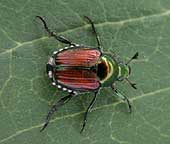

The Japanese Beetle is a metallic green color and coppery-brown wings. They can grow to be 1/2 of an inch long as adults. The Japanese beetle is a good flyer and often moves in a swarm from one area of plantlife to another.
As the name suggests, this insect was first seen in Japan. However, today the Japanese beetle is common throughout the USA, Canada, and parts of Mexico. It likes open fields, meadows, or gardens--anywhere where it can find lots of plants to eat. Japanese beetles will eat almost anything: garden flowers, leaves, berries, and even vegetable crops such as corn or beans. For this reason, it is considered a serious garden pest by humans.
Japanese beetles usually emerge from the ground in the beginning of July and can be found right through September. Soon after they arrive, they begin to mate. Females will lay eggs in the ground that hatch by early August. Young Japanese beetles are called grubs. They are tiny white specks that feed from early August until winter cold forces them to hide deep underground. After hibernating through the winter, the grubs move to higher soil levels to feed again in May and June. Around mid-June, the grubs turn into pupae and come out of the ground as adults in July.